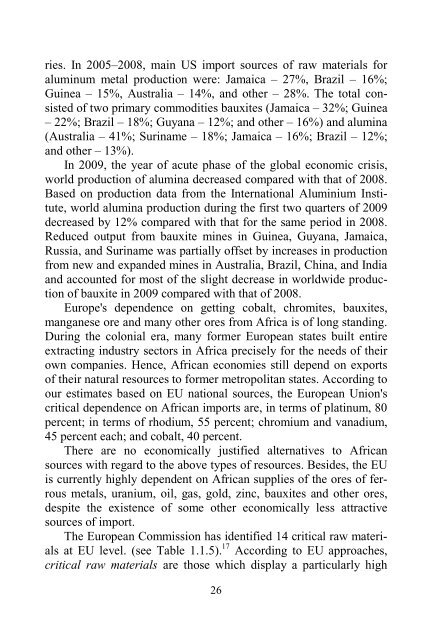L. Fituni, I. Abramova Resource Potential of Africa and Russia's ...
L. Fituni, I. Abramova Resource Potential of Africa and Russia's ...
L. Fituni, I. Abramova Resource Potential of Africa and Russia's ...
You also want an ePaper? Increase the reach of your titles
YUMPU automatically turns print PDFs into web optimized ePapers that Google loves.
ies. In 2005–2008, main US import sources <strong>of</strong> raw materials for<br />
aluminum metal production were: Jamaica – 27%, Brazil – 16%;<br />
Guinea – 15%, Australia – 14%, <strong>and</strong> other – 28%. The total consisted<br />
<strong>of</strong> two primary commodities bauxites (Jamaica – 32%; Guinea<br />
– 22%; Brazil – 18%; Guyana – 12%; <strong>and</strong> other – 16%) <strong>and</strong> alumina<br />
(Australia – 41%; Suriname – 18%; Jamaica – 16%; Brazil – 12%;<br />
<strong>and</strong> other – 13%).<br />
In 2009, the year <strong>of</strong> acute phase <strong>of</strong> the global economic crisis,<br />
world production <strong>of</strong> alumina decreased compared with that <strong>of</strong> 2008.<br />
Based on production data from the International Aluminium Institute,<br />
world alumina production during the first two quarters <strong>of</strong> 2009<br />
decreased by 12% compared with that for the same period in 2008.<br />
Reduced output from bauxite mines in Guinea, Guyana, Jamaica,<br />
Russia, <strong>and</strong> Suriname was partially <strong>of</strong>fset by increases in production<br />
from new <strong>and</strong> exp<strong>and</strong>ed mines in Australia, Brazil, China, <strong>and</strong> India<br />
<strong>and</strong> accounted for most <strong>of</strong> the slight decrease in worldwide production<br />
<strong>of</strong> bauxite in 2009 compared with that <strong>of</strong> 2008.<br />
Europe's dependence on getting cobalt, chromites, bauxites,<br />
manganese ore <strong>and</strong> many other ores from <strong>Africa</strong> is <strong>of</strong> long st<strong>and</strong>ing.<br />
During the colonial era, many former European states built entire<br />
extracting industry sectors in <strong>Africa</strong> precisely for the needs <strong>of</strong> their<br />
own companies. Hence, <strong>Africa</strong>n economies still depend on exports<br />
<strong>of</strong> their natural resources to former metropolitan states. According to<br />
our estimates based on EU national sources, the European Union's<br />
critical dependence on <strong>Africa</strong>n imports are, in terms <strong>of</strong> platinum, 80<br />
percent; in terms <strong>of</strong> rhodium, 55 percent; chromium <strong>and</strong> vanadium,<br />
45 percent each; <strong>and</strong> cobalt, 40 percent.<br />
There are no economically justified alternatives to <strong>Africa</strong>n<br />
sources with regard to the above types <strong>of</strong> resources. Besides, the EU<br />
is currently highly dependent on <strong>Africa</strong>n supplies <strong>of</strong> the ores <strong>of</strong> ferrous<br />
metals, uranium, oil, gas, gold, zinc, bauxites <strong>and</strong> other ores,<br />
despite the existence <strong>of</strong> some other economically less attractive<br />
sources <strong>of</strong> import.<br />
The European Commission has identified 14 critical raw materials<br />
at EU level. (see Table 1.1.5). 17 According to EU approaches,<br />
critical raw materials are those which display a particularly high<br />
26







